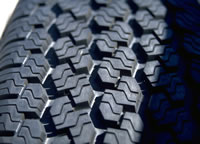
Over a recent weekend I drove several hundred miles on the Interstate system. On Friday, I saw a vehicle flipped upside down in the median. Since there were no emergency responders on the scene, I stopped to try to help. When I got to where the vehicle was, volunteers were already helping the driver out of a back door window. She was dazed but not injured and told us the accident was due to a blowout (which is a rapid loss of air in a tire). I checked and there was a shredded tire on the rear of her vehicle.
The next day I was again traveling on the Interstate and saw a vehicle ahead of me swerve violently and then run into the grassy median and completely roll over. Remarkably, it ended right-side-up and out jumped 5 or 6 people, many of whom were injured (none critical but still requiring emergency assistance). About a dozen people, including several ER nurses, immediately stopped to provide assistance. One of the injured passengers told us that they had experienced a blowout that caused the wreck.
I checked their vehicle and saw a shredded tire on the rear as well. Sadly, unlike the tire from the other wreck mentioned above, the tires on this vehicle were badly worn and should not have been driven. They should have been replaced weeks ago. Driving on tires with more tread life would likely have prevented that accident.
It was seeing the impact of these worn tires that brings me to the main point for this article: Saving money on preventive maintenance may not be saving money after all. Skipping or postponing required maintenance could end up costing you much more. In this example, replacing worn tires instead of risking a few more weeks on them probably would have averted at least one costly and dangerous wreck. The same can be said for changing air conditioner filters monthly, replacing contact lenses at recommended intervals, getting annual medical checkups and physicals, and so forth. Prevention is usually much less costly (and painful, frustrating, etc.) than the cure. In short, cutting corners on prevention probably does not save any money in the long run and likely costs a whole lot more.
Accidents can happen even under the best of conditions and after following all preventive maintenance recommendations. With the above financial point fresh in mind, there remains one other thing I’d like to share.  Needless to say, the results of these tire blowouts were disturbing. I began to ask questions: Do some blowouts automatically produce a serious wreck? Is there anything a driver can do to regain control after a blowout and prevent an accident?
Needless to say, the results of these tire blowouts were disturbing. I began to ask questions: Do some blowouts automatically produce a serious wreck? Is there anything a driver can do to regain control after a blowout and prevent an accident?
I did some research on these things and learned that drivers can successfully manage blowouts. The bottom line is blowouts don’t have to cause accidents; however, many drivers overreact and make the situation worse which can lead to wrecks and serious injury.
I’ve embedded a video below that was produced in cooperation with the tire company Michelin. It provides step-by-step instructions for successfully handling tire blowouts. Please note that while RVs are featured in this video, the principles for recovering from a tire blowout are the same for all vehicles. RVs, because of their large size and challenging distribution of weight, provide a great case study for learning how to do this. Please watch this video so you’ll know what to do if you ever experience a blowout in a vehicle you’re driving. What you learn here could save your life.
This post was last updated on July 19, 2023.
Copyright © 1999 - 2025. Shopping-Bargains.com, LLC. All rights reserved.